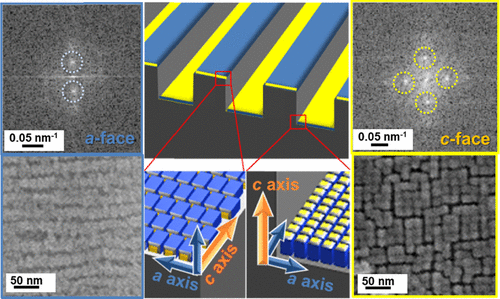Our official English website, www.x-mol.net, welcomes your
feedback! (Note: you will need to create a separate account there.)
Spatial Control of Crystallographic Direction in 2D Microarrays of Anisotropic Nanoblocks on Trenched Substrates
Langmuir ( IF 3.7 ) Pub Date : 2017-11-20 00:00:00 , DOI: 10.1021/acs.langmuir.7b03264 Riho Matsumoto 1 , Yoshitaka Nakagawa 1 , Kazumi Kato 2 , Yuya Oaki 1 , Hiroaki Imai 1
Langmuir ( IF 3.7 ) Pub Date : 2017-11-20 00:00:00 , DOI: 10.1021/acs.langmuir.7b03264 Riho Matsumoto 1 , Yoshitaka Nakagawa 1 , Kazumi Kato 2 , Yuya Oaki 1 , Hiroaki Imai 1
Affiliation

|
Elaborate two-dimensional (2D) microarrays of tetragonal Mn3O4 nanocuboids 10–20 nm in size were constructed with parallel trenches 500 nm wide and 500 nm deep on a silicon substrate. By adjusting the conditions, including the dispersion medium, particle concentration, and evaporation rate, the a-face and c-face 2D arrays were selectively deposited on the upper and lower stages of the trenches, respectively. The crystallographic direction of the tetragonal crystal was alternately switched in the 2D microarrays under these specific conditions at the optimal particle concentration and evaporation rate. Spatial switching of their crystallographic direction was achieved via interaction of the anisotropic nanoblocks and the specifically shaped surfaces.
中文翻译:

沟槽基底上各向异性纳米嵌段的二维微阵列中晶体学方向的空间控制
精心制作的尺寸为10-20 nm的四方Mn 3 O 4纳米立方的二维(2D)微阵列,在硅基板上具有500 nm宽和500 nm深的平行沟槽。通过调整条件,包括分散介质,颗粒浓度和蒸发速率,a面和c平面2D阵列分别选择性地沉积在沟槽的上部和下部。在这些特定条件下,以最佳的颗粒浓度和蒸发速率在2D微阵列中交替切换四方晶体的晶体学方向。它们的结晶方向的空间转换是通过各向异性纳米嵌段和特定形状的表面的相互作用实现的。
更新日期:2017-11-20
中文翻译:

沟槽基底上各向异性纳米嵌段的二维微阵列中晶体学方向的空间控制
精心制作的尺寸为10-20 nm的四方Mn 3 O 4纳米立方的二维(2D)微阵列,在硅基板上具有500 nm宽和500 nm深的平行沟槽。通过调整条件,包括分散介质,颗粒浓度和蒸发速率,a面和c平面2D阵列分别选择性地沉积在沟槽的上部和下部。在这些特定条件下,以最佳的颗粒浓度和蒸发速率在2D微阵列中交替切换四方晶体的晶体学方向。它们的结晶方向的空间转换是通过各向异性纳米嵌段和特定形状的表面的相互作用实现的。











































 京公网安备 11010802027423号
京公网安备 11010802027423号